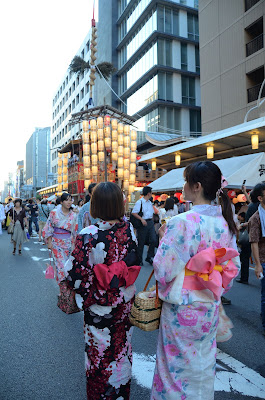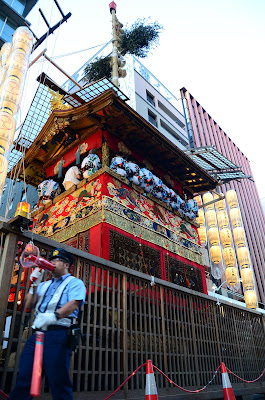Just two days before the big Gion Matsuri Festival in Kyoto, I found myself sweating a lot going from one must-visit spot to another. It was hot and humid and it seem like more people have jostled themselves into an already crowded city in anticipation of this big Japanese festival. Around 9 AM, I hopped on a bus at the rail station and hoped I wouldn't miss the correct bus stop. Luckily, there was a couple holding an obvious tourist map. They were Japanese but they knew exactly where I want to go when I uttered "Kinkakuji". After a 40-minute bus journey, I made it there.
Kinkakuji isn't of course a bus stop. It's a very popular Zen temple. The Japanese couple also alighted from the bus and in halting gestures, pointed in the direction where the temple is - which was where they were also going. I smiled, thanked them and walked ahead. Kinkakuji can't be seen right away from the road as it's hidden, tucked in this beautiful garden complex with a gorgeous pond. Admission is 400 yen. As most visitors are wont to do, I headed straight for the main attraction - the temple itself. Covered in gold, Kinkakuji is also known as the Golden Pavilion. It's part of Kyoto's list of temples included in the UNESCO World Heritage site.
My map showed that another UNESCO World Heritage site was just nearby. I walked to it, trying to save some yen but it actually cost me more in literal sweat equity. Some 25 minutes later, I arrived at the gate of Ryoanji Temple dripping like a melting glacier. I was fanning myself furiously while gulping down my second bottle of green tea. Entrance fee is 500 yen. There's also a beautiful garden complex that will really tempt to steal your time here but I was more focused on seeing one thing only - Ryoanji Temple's rock garden. If there's anything about Zen that you want to see and think about, this is it.
There I sat on a wooden platform, eyeing each and every piece of mossy rock meticulously arranged on a sea of raked gravel. Every other person I see was also looking intently, as if trying to squeeze some meaning out from these abstract installations. It wasn't crowded like it usually happens on most days but my meditative state of mind was empty (perhaps from all that sweating). Even if I heard that one rock resembled a tiger leaping across an island, nothing really meant to me. Nakakabato talaga. Reading haiku was probably easier.
Then it hit me. Looking at those rocks made me look inwards, deeper into my own being. That's when I sensed a feeling of serenity and calm. Even heat and humidity didn't bother me that time. Now I begin to see why so many parks and many properties elsewhere in the world try to incorporate a rock garden in their designs. Looking at them help instill some sense of peace and tranquility. It may sound like mush but the effect can be profound indeed to anyone who sees things a bit differently, especially to someone who's tired or stressed out. It's like a catharsis in the face of chaos. At least I came out of this temple feeling rejuvenated.
From the rock garden, I took another bus, this time going into the center of town to see another UNESCO World Heritage site. Nijo Castle, built in 1603, was where the first Shogun of Japan's Edo Period lived. When I entered the castle, I began to think of the fabled samurai class. Amidst those wondrously creaking floors and sliding doors, I can't help but think of the members of this warrior class as they strictly follow bushido - "the way of the warrior" code of conduct. This meant showing honor, courage and loyalty to their master. As I walked from one barren room to another (no furniture just as how it's always been), I see the simplistic design as another way to express such conduct. Very austere yet effective. Unfortunately, no pictures are allowed. Entrance fee is 600 yen.
By the time I was done, it was past 2 PM. I took the subway this time back to the rail station where I had a late Tonkatsu lunch. Not wanting to be roasted any longer, I walked back to the comfort of my airconditioned ryokan and ended up taking a long siesta. When I woke up, it was already 7 PM. I stepped out of my room and as soon as I went into the lobby, one of the ryokan staff quickly laid out my sandals for me - what a pampering. I got self conscious as three of them watched me changed my footwear and then just as I was about to turn, each one of them gave me a bow. And I bowed back, so impressed as usual by this traditional gesture of respect.
During the 3 nights leading up to the main event of Gion Matsuri Festival, some streets in Kyoto are closed to vehicular traffic to allow some celebration. It was the second night, called yoiyoiyama, with many things happening mostly around the area of Karasuma Street, just a few minutes walk from my ryokan. Gion Matsuri began as a religious purification ritual aimed at stopping catastrophes and epidemics. In time, it evolved into a way for showing off excellent craftsmanship and good taste through a parade of big floats - the very highlight of this festival. It is during these 3 nights prior to the parade that visitors can see the floats up close, usually as high as a two-storey building and topped with what looked like a spear.
Besides the floats, there were food stalls. Plenty of them. It was a great way for me to have dinner just by going from one stall to another trying to sample as much as I can. Because everyone else seems to have the same agenda - to eat - the streets were so packed with people it became tedious moving slowly from one corner to the next. Despite that and the oppressive humidity, the festive mood was hanging so heavily in the air. There's music coming from some strange instruments. Lanterns were all lit up. Kids wore their yukata along with dad and mom. If the gods can truly be appeased by a month-long Gion Matsuri Festival, I can now understand why this has been celebrated every year since 869.
















i smiled when i read your line with
ReplyDelete'Nakakabato talaga' then i am with you in the idea of tranquility. we need to enjoy time alone in somewhere quiet (hopefully not humid--namili pa ako!)and relaxing. often, those moments are luxury!
on a lighter note, the tonkatsu lunch looks yummy(what did you drink to wash down? -tea?) and man, i want yakitori! have you tried those grilled stuffs?
Ah, Kinkakuji is again one of those places that was relatively near to where we were and yet we never went to; I am glad you were able to see it for yourself.
ReplyDeleteAnd takoyaki? Now we're talking business! I hope you tried them!
this trip is really amazing. did you time it to coincide with this festival? how affordable are those food carts?
ReplyDeletedocgelo,
ReplyDeleteIt was very relaxing being in the rock garden - exactly just what I needed going through the summer madness of a big city. I hope to find one like that in NYC. As for my meal, I merely washed it down with cold green tea - offered by restaurants all summer long.
Jeruen,
There's one thing I missed (though not part of Kyoto) - Himeji castle which is currently under extensive renovations. In a way, it's good to miss something so I have a very good reason to go back. And yes, those octopus balls are darn good!
Photo Cache,
It was purely luck that my trip fell on one of the days the festival was being celebrated. The street food was good and reasonably priced!
Amazing pictures from you as usual, i'm a silent reader here, mukhang ngayon lang ata ako makakapag comment, but anyway, you captured one of my favorite dimsums, takuyaki, how i love it with toyo and kalamansi. Nice way to explote Kyoto, just in time with their festival.
ReplyDeleteFunny, the thing you missed is the thing I remember seeing; we went to Himeji Castle when I was 16 I think. Although come to think of it, I still would not mind seeing it again, as I haven't appreciated the art of taking photos at that young of an age.
ReplyDeleteAnd you bring a very interesting point: I always find it to be the case that if there is something you haven't seen and wished you had, then the trip would be more memorable. If you visited a place and saw everything, then chances are the overall memory you'll get is one such that you would think that there's not a lot to see. After all, you have seen everything. But if you haven't, then there's a reason to go back. Perhaps that is the reason why I opt to not try and see EVERYTHING and purposely leave a few bits and pieces, so that there's the simmering desire to go back and visit the place again, at some point in time.
I still have the pic I took of the Golden Pavilion in 1967. Yours is fresher although the subject is 44 years older LOL.
ReplyDeleteim really impressed at how they would design their indoor garden and landscape.
ReplyDeleteshengmarie,
ReplyDeleteIt's heartwarming to hear your thoughts now that you've finally come out from being a 'silent reader'. I appreciate it very much.
Jeruen,
Glad to know we're on the same boat on this: there's really no point in trying to cram all sights in one single trip and end up with blurry experiences. It defeats the purpose of immersing one's self in another country's culture. While it may be a challenge for most of us to return (money, work, etc), I'd mark sights I will be missing for a future trip. By that time, Himeji castle will be back in its old grandeur - just the way you saw it as a teen.
bertN,
wow! I know you told me about a long term stay you did in Japan but I didn't realize it's way back in the 60s!
dong ho,
No surprise why Japanese gardens are copied everywhere. There's even one in Manila's Rizal Park, right?